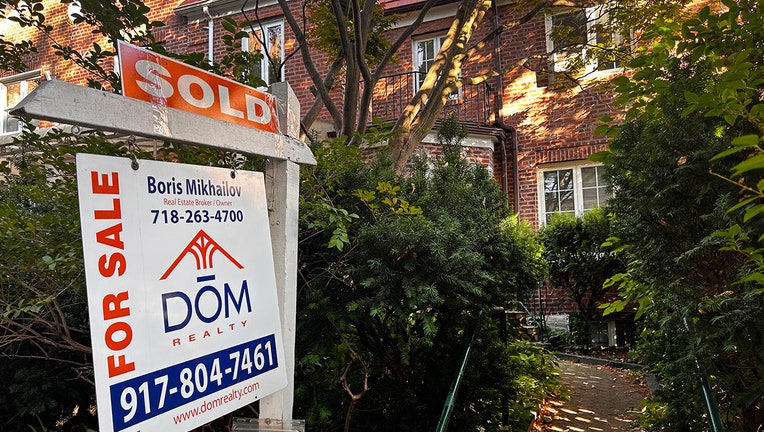Nearly half of recent buyers have mortgage rates below 5%, Zillow says – here's how

FILE- House "Sold" sign out front of a residential home in Queens, New York. (Photo by: Lindsey Nicholson/UCG/Universal Images Group via Getty Images)
SEATTLE - Despite average mortgage rates being much higher, nearly half of homebuyers in the past year report having a rate below 5%, according to a new survey by Zillow.
Mortgage rates hit historic lows of 2.65% in 2021, and surged to decade-long highs of 7.79% by the fall of 2023. Zillow said the average mortgage payment rose 115% from before the pandemic to a recent peak in May 2024.
Mortgage rates hit highest level in 20 years (Feb. 26, 2024)
The average long-term U.S. mortgage rate jumped to %7.09%, its highest level since April of 2002, according to Freddie Mac. One year ago, the rate averaged 5.13%. LiveNOW's Andrew Craft spoke about mortgage rates with Uri Man, CEO of Lagoon Management. More LiveNOW from FOX streaming video
This big increase in rates impacted the options for homebuyers, and for some, has prevented them from buying altogether.
But according to Zillow’s latest research, some determined buyers have found creative ways to afford homeownership over the past 12 months.
The average 30-year, fixed-rate mortgage currently stands at 6.54%, according to FreddieMac. Zillow’s survey found that 45% of people who purchased a home in the past year managed to secure a rate below 5%.
"This surprising finding really underscores the creativity of both buyers and sellers navigating today's dynamic real estate market," Amanda Pendleton, Zillow's home trends expert, said in a statement.
"Buyers are finding innovative ways to secure a lower mortgage rate, but sellers are also coming up with financing solutions to make their property more attractive to a potential buyer," Pendleton added.
Zillow’s survey found that more than one-third (35%) of these recent buyers were able to get a lower rate because the seller or home builder offered them special financing.
About one-quarter made their offer contingent on a rate buydown (26%), which can involve purchasing discount points (or mortgage points) at closing and paying a one-time fee upfront.
A quarter of those in the survey refinanced to a lower rate after buying, and 23% said they borrowed from a friend or family member.
How to get a lower mortgage rate
Hoping to move? There are several ways potential buyers can get a lower mortgage rate in the homebuying process.
- Focus on credit score. A higher credit score often leads to a lower interest rate, Zillow noted, saying that buyers should prioritize boosting their credit score and maintaining it all the way through closing. This means don’t open new lines of credit or make large purchases, such as a new car.
- Consider rate buydowns and mortgage points. Mortgage rate buydowns or purchasing mortgage points to lower interest costs on a loan can be another option. Zillow explained how a rate buydown involves an upfront payment for reduced rates in the early loan years, while buying points results in ongoing savings on monthly payments throughout the term of the loan. "When buying a new-construction home, the builder may cover these costs as incentives," Zillow said. "If this is not the case, negotiating with the seller or builder is always an option."
- Put more money down on the home. A higher down payment decreases the loan size and the risk for the lender, which can often mean a lower mortgage rate. Zillow noted how this can be challenging for many, as it found that 44% of first-time buyers used either a gift or loan from family or friends. There are also resources for down payment assistance programs. Zillow said that among recent first-time buyers who used a mortgage, 60% received some sort of down payment assistance.
- Consider ‘house hacking.’ "If it aligns with a buyer's lifestyle, renting out rooms in their home to produce rental income can reduce their mortgage rate," Zillow said. "Recent mortgage buyers who included projected rental income in their application were more likely to secure a mortgage rate below 5% than those who did not."
- Research nontraditional loan types. A 30-year, fixed-rate mortgage is the most common loan type, but there are others that homebuyers can consider. An adjustable rate mortgage (ARM) features an initial lower interest rate that can change to the market rate after a fixed period, typically three, five, seven or 10 years, Zillow said. The main downside of an ARM is that rates could be higher when the initial period ends, leading to higher payments down the line. A shorter loan term, such as a 15-year mortgage, comes with much higher monthly payments since the loan is being paid off more quickly, but also has lower interest rates.

